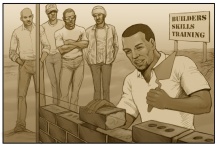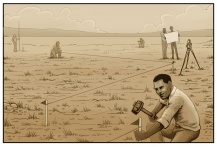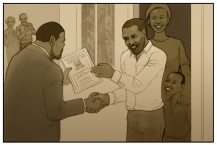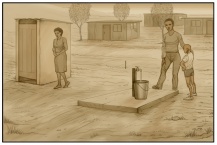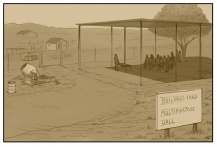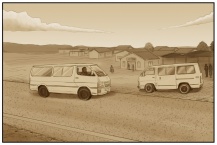Story 2: Basic Product

Pam and her friends from the savings schemes now have approval to undertake a Managed Land Settlement pilot project in Bongweni on the church land.
Attention now shifts to planning what the blocks will look like, how tenure will be secured and how to get some basic level of services onto the land.
Contents |
Basic organisation
One of the most exciting times of the whole development was when I heard that the municipality had approved the development of the church land. It had taken us about a year from when the church and savings schemes signed the Memorandum of Understanding (MoU) to when the municipality approved the framework plan (or sub divisional area plan) that created the superblocks.
During this time, while the planners, engineers and other professionals were doing all the things outlined in the Bulk Preparation phase, our savings schemes had not been idle.
We managed to arrange for some of our members, including my partner Temba, to attend a training course in construction skills, like pipe-laying and bricklaying so that we would have labourers from our community to work on any construction work that was needed in future. This was paid from the Department of Labour.
While we were still living in Squatter Camp and other areas of Eden Ridge Township, the Development Support Organisation organised a skills training course for our savings schemes on leadership skills and how to run meetings, get mandates and report back to members. We gained some useful basic knowledge at these training sessions that helped us run our organisations more efficiently.
Visit Organising for more information and discussion on this topic.
Basic planning / demarcation
The Church, on the advice of Development Support Organisation, arranged for a professional land surveyor to mark out the outer boundaries of the blocks as per the sub divisional area plan that was approved at the end of the bulk preparation phase.
One of the most uplifting experiences I had throughout the whole development process was when Temba and I (and the other savings scheme members) participated in a two day workshop, organised by Development Support Organisation and the planning working group that we established in phase 1,to develop layout plans for household plots within each of the blocks. We had organised taxis to take us to this workshop which happened at Congregation Church on the church land.
Development Support Organisation had produced a manual on how to layout plots, which they presented at the workshop. This was the first time that I was able to really think about what type of neighbourhood I would like to live in. I was able to think about how to make my dreams come true.
- At the workshop we broke up into groups according to our savings schemes/ blocks.
- We then walked to our actual blocks and looked around to see what was there. Big flags had been placed at the corners of the superblocks so we could see exactly where the blocks were.
- We then went back into the church hall, and brainstormed what type of environment we would like to have. These ideas were presented back to the other schemes and other role-players present and comments and suggestions were made.
- We were then given a large aerial photograph of our piece of land and used tracing paper and paper squares, cut to the size of an average house on the aerial photograph, to look at different ideas as to how we would like our houses to be laid out in the block.
After the workshop the planners contracted by Development Support Organisation copied the provisional house positions we had shown on the aerial photograph. They then used this to make rough plot and street plans on another large aerial photograph.
A pegging task team, that included Temba, was elected and came back later and marked out the plots on the ground, using a tape measure, pegs and string. A few minor adjustments had to be made so that things like storm water gullies did not run through the middle of a person’s plot. This opportunity gave Temba much more confidence that he would be able to tackle almost any challenge that came to him in future.
Visit Land and Planning for more information and discussion on this topic.
Basic tenure
At the end of the bulk preparation phase the church land was rezoned to a sub divisional area with special zoning for incremental settlement. This already started to give us tenure security as the land was properly planned and shown in the municipality’s plans as an area where people could live.
Now that we knew who was going to be staying in the different blocks in the Bongweni community, the savings schemes began to discuss what people would be able to do on the land. Development Support Organisation held a few meetings with the savings scheme members to discuss this as well as what rights they would have on the land, how they could be protected from eviction and how land use would be administered.
It was agreed that Congregation Church would initially keep ownership of the land and in future, when government housing subsidies were obtained, those people that wanted individual ownership could then get their plots transferred into their names. But the church did not want to play a significant role in managing people’s rights and uses. It was important to them that the number of houses to be built in the area, should be limited to the number of plots decided upon Prior to anyone moving onto the land in the Bongweni community, the planning working group with the support of Development Support Organisation conducted a survey to determine what rights people expected to get once they settled on the land. This was presented at a workshop. The following points came out of this exercise:
- Everyone agreed that we have a right to settle on the land and we called this a an occupation or a use right
- Everyone wanted to be able to build a house and we called this the right to make improvements on the land. We were less sure about whether building plan approval for a formal house was needed (i.e. one made from bricks)
- eople wanted to be able to pass on their land to their children and we called this the right to bequeath our land
- Everyone would need to pay a small fee to the savings scheme to administer things. We were lucky that the Church, as land owners, did not require any fee or rental. We agreed that payment of this charge (to the savings schemes)would be one of the obligations that come with the rights to occupy/use, make improvements and bequeath. People agreed that the savings’ scheme has the right to make this charge.
- People wanted to be able to run small businesses on their sites but we agreed that they would need permission first, not from the municipality necessarily but, firstly from their block committee (which was created from the same people as the original savings schemes), and then from the church. Usually the church would ‘rubber stamp’ the block approval, unless there was a dispute of some sort, in which case the church would try and mediate. These are use rights. While the first right is a right to residential use we understood that this right is for non-residential, economic uses.
- We were undecided about whether people should be allowed to sell their properties but in the end we agreed that for as long as the church owned the land, it would be unfair to make a profit if you need to move. However, if you have built a house then you have a right to recover the costs of that. This made us realise the importance of administering tenure rights, otherwise people might land up being insecure because things become unclear. We understood this to be all about processes and procedures, rules and monitoring.
- A register would be kept of who has rights and obligations and where they have them. The register would build on the allocation list (see section on bulk allocation in bulk preparation phase) and contains names and a plot number so that we have a way of identifying who has rights and where they have them
- We also came up with some neighbourhood rules – quite like house (or block) rules of occupation – that looks at issues such as what to do if you want to rent out a room or a backyard structure, or if you want to put relatives in your place if you need to leave). We decided to also put dispute resolution procedures into our resident’s association rules in case there are conflicts. We felt that the Congregation Church might be able to play a role in supporting conflict resolution, but we decided we would develop the procedures over time.
- We also agreed that the occupation register would need to be managed and that the rules would need to have a clear authority ‘person’ or structure to back them up. So we agreed that we would make this the job of the residents’ committees of the blocks.
- The register would record both the husband and wife (or co-habitors if not married) so as to ensure that both the man and women would have tenure security. Children’s names would also be kept on the register.
- Development Support Organisation clarified for us that these two things together – the register and the procedures – will give meaning to what we call tenure security, as long as they have support and legitimacy.
- However, some people in the workshop were unhappy that they would not be receiving a piece of “paper” of their own proving that they have the right to stay on the land, so we agreed that we would ask the Congregation Church to write a letter to each household saying that they agreed to their settlement on the church land, provided that no additional plots were demarcated and more households moved into the block.
See the section on aided local tenure administration in phase 3 (aided self development) to see how we managed our local tenure system for both the plots and the common space.
All households signed the occupation register kept by the residents committees of the blocks just before we moved onto the land and the church gave them their occupation letter. We had a big party after this was done. It was a big milestone for all of us who had been working for so long on this project. These celebrations played an important part in keeping us all involved and motivated to keep going thought this long process.
Visit Tenure for more information and discussion on this topic.
Basic services
At a workshop, organised by the engineering consultants appointed by Development Support Organisation with the savings’ schemes/ blocks; it was explained that waterborne sewerage would not be possible as there was no bulk infrastructure.
The following services were agreed to for all the blocks as a start:
- One composting toilet for every 4 houses (the engineers called it a double vault urine diverting composting toilet).
- At least one communal standpipe (or tap) per block with soak away pit for waste water coming from the tap (or within 200 meters from the furthest house). The water would come from a borehole on the site.
- Lined storm water drainage at the main crossing into the block. No work would be done on the roads at the start.
The savings schemes all agreed to use their savings money to put in these communal water pipes, communal toilets and lined storm water.
Development Support Organisation later helped us negotiate a big discount for a solar light for each communal toilet.
A local gardening club also agreed to provide a zero interest loan to the savings schemes to provide a package that included poles, corrugated iron roofing sheets, gutters and a water tank for each house. Households interested in the package took out loans, at very reasonable interest, from the savings’ scheme to get this package. Most households took this loan and the material was stored in a shed at the church. Our family took out one of these loans and we started to pay this loan back even before we moved into the houses. (See the section on Aided resource mobilisation for more on this)
There was concern, from the start of discussions, about communal toilets - over who would clean and maintain the toilets. I knew, along with the other women, that this job would probably fall to us, and we were a little worried about how many activities we were taking on, throughout the development process. But in the end this did not become a problem as, after about 6 months, one of the households that were doing agricultural activities on nearby land (see the ‘self growing’ section, in phase 3 aided self development) arranged to collect all of this human compost themselves for their community garden orchard.
The Development Support Organisation helped us as the savings’ schemes to enter into a combined contract with a local builder for installing the basic services. The contract stipulated that local labour would be used. Each block nominated a builder and the flood victims also nominated a few labourers. Most of these labourers had attended the skills training we had organised earlier. The plots were marked out and ready to move onto before the basic services were put in. We arranged with the original flood victims, who were already on the land, for some of our savings’ scheme members to stay with them for a few days so, that these people could build the basic services without having to travel between Squatter Camp and the church land every day. This way we were all able to move onto a site in the Bongweni community that was pegged and had basic services ready for us.
See the section on Aided Local Tenure Administration, in phase 3 (aided self development) for a discussion on management of monthly fees for water and common space maintenance.
Visit Services and Facilities for more information and discussion on this topic.
Basic facilities
There were no community facilities in the area prior to and immediately after people moved onto the land. We were lucky that we could use a room in the church for meetings.
This church room was not ideal, as it was small and often used by the church, and so fairly soon we decided to build a roof-on-pole structure for a multi-purpose meeting space and builder’s yard. This was built used using some of the money we had saved when we changed the design of the communal toilets to make them cheaper. Members from Bongweni community also volunteered their time and labour to build this structure.
One of the main problems for us however, was that there were no schools and clinics in the area. The children had to catch a taxi to get to school in the old community. It was only 2 years after we moved onto the church land that the Department of Education built and staffed a small primary school in the area (see upgrade facilities section in phase 4 (upgrade phase).
In future, if we had to do this project again, we would work harder to try and get a primary school in the neighbourhood at the same time as the people moved into the area.
We were able, with the support of the ward councillor, to get a mobile clinic to visit us once a month. This clinic was also used by some of the neighbouring farm workers.
Visit Services and Facilities for more information and discussion on this topic.
Basic access
Most of us had to rely on public transport to get to opportunities in other parts of the town. Very few of us had our own cars.
When we had the workshop on what we would like our neighbourhood in Bongweni to look like, there was a lot of debate about cars and how the streets would look. It was decided that we would make the street like a big communal room, with the sky as the roof and the houses and trees as the walls, where children could play and adults could socialise. This was more like what we were used to in the informal settlements, old townships and rural areas. We did not want a normal suburban street where cars made it dangerous to walk and play in the street. The planners called this a ‘woonerf’ or ‘living plot’.
We also planted some trees and made a small shelter were the taxis could stop so we could wait out of the sun and rain. The place where the taxis stopped was not planned but just grew as commuters and taxi drivers found it convenient to stop in one particular place.
Visit Access for more information and discussion on this topic.
Basic financing
When we started this project it was not clear where the funding would come from to put in the basic level of services and provide us with basic tenure.
As savings schemes or blocks we had to rely on donations and our own savings to be able to get to a stage where we could move onto the land. This meant that what we were able to put in was very basic; but we knew that this was only the start and we would find money from others and the government to make the area much better over time. At least we had somewhere to stay and were no longer living in the poor conditions of Squatter Camp and other informal settlements. We also knew we would not be kicked off the land.
The evaluations that were done on the project after we moved onto the land by the provincial government, the Development Support Organisation and also by some students highlighted that this bulk and basic financing issue was an area where government needed to direct a lot more financial support.
Most of us from informal settlements and in other poor living environments are prepared to start off with just a well located piece of land with basic tenure and services as long as we know that there are plans in the long run to improve the area. (See section on Diagnosis and Planning in phase 5 (maintenance and improvement)
Visit Financing for more information and discussion on this topic.
Comments
Join the MLS conversation: Comments page

